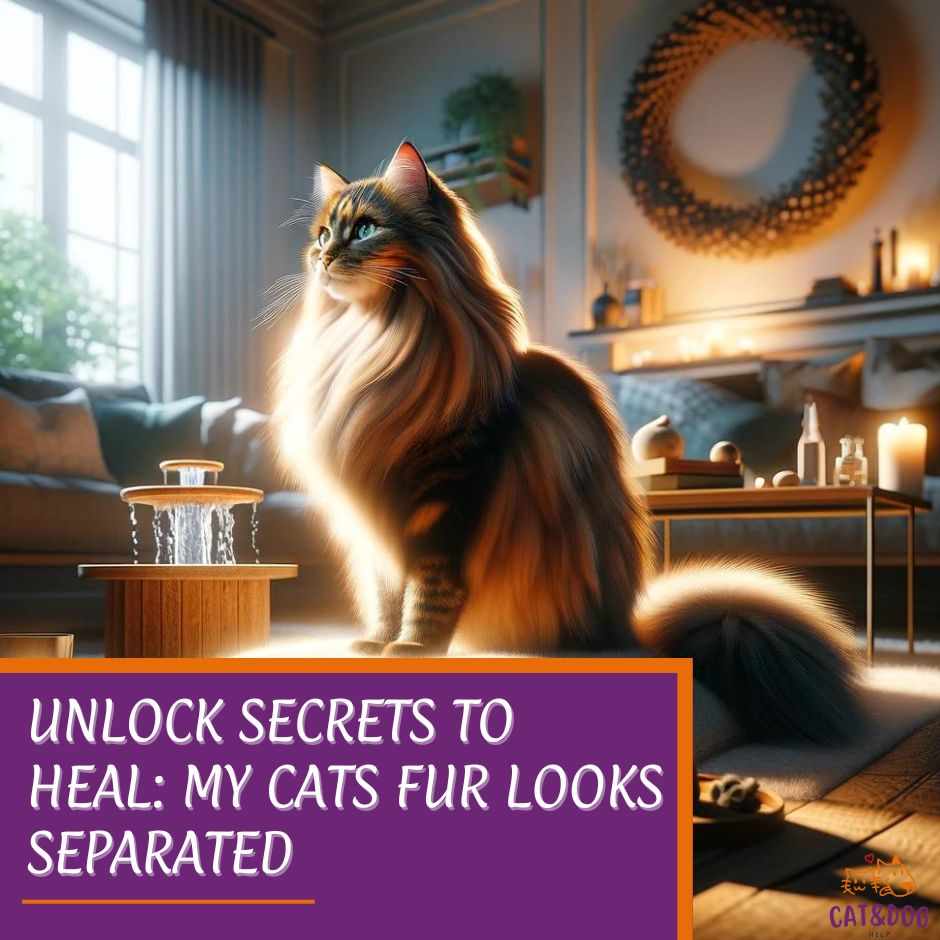Why does my cats fur looks separated? The question might arise in your head when you notice your cat’s fur looking a bit…off.
Perhaps the once silky smooth coat now seems to have taken on a life of its own, with strands defiantly separating or bunching up like the bristles of a used toothbrush.
You’re not alone in this feline fur dilemma.
While cats are known for their impeccable grooming habits, a variety of factors can cause their fur to look separated into tiny clumps or rows, giving their fur a clumping and spiky look, or just plain shabby due to parasites such as fleas, ticks, and worms.
This can be caused by a buildup of dead hair and grease on the fur, making it easier for parasites to latch on and cause further issues for your cat’s skin.
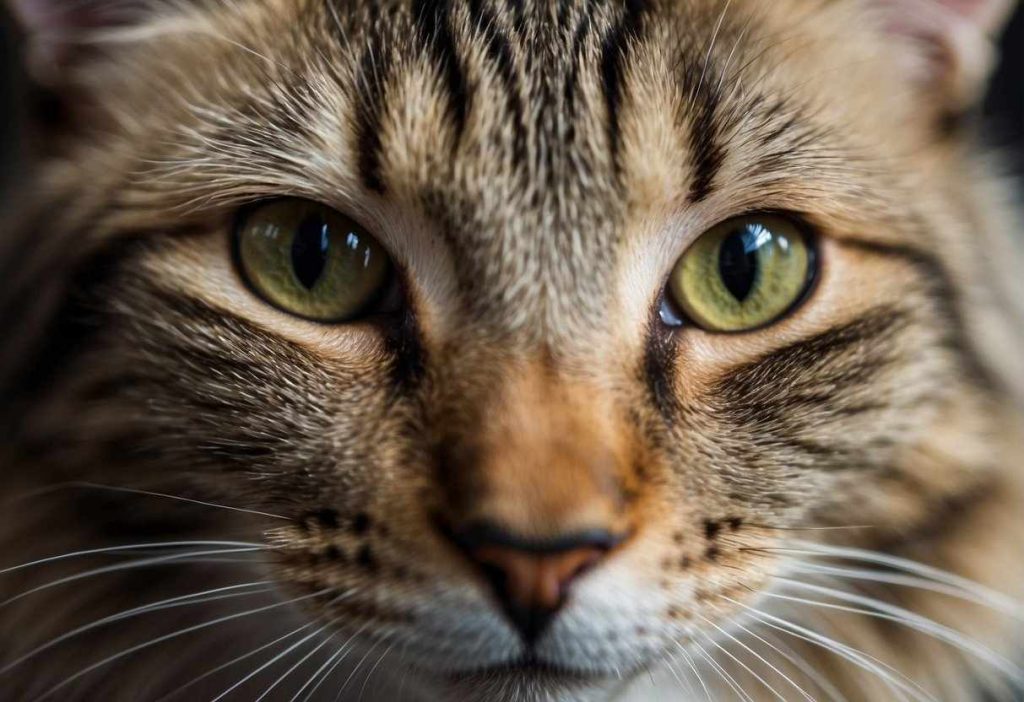
So what’s causing this feline fashion faux pas? Be it due to a dip in grooming enthusiasm or underlying health issues, the fact is that the state of your cat’s coat can tell you a lot about their well-being.
Obesity, skin irritations, or the natural progression of age can turn a cat’s coat from fluffy to frizzy and can even lead to skin problems like itchiness.
Meanwhile, environmental factors, diet, and the presence of parasites, such as chronic diarrhea, can also play a less than glamorous role in your kitty’s coat condition, including a greasy coat.
It’s important not just for aesthetics, but for your furball’s health, to understand why this fur phenomenon occurs and what can be done about it.
Key Takeaways
- Changes in your cat’s fur could signal health issues or a need for dietary and grooming adjustments.
- Regular vet check-ups and proper grooming can prevent and address fur separation.
- Understanding your cat’s specific needs and behaviors is essential for maintaining a healthy coat.
My Cats Fur Looks Separated: Comprehensive Causes
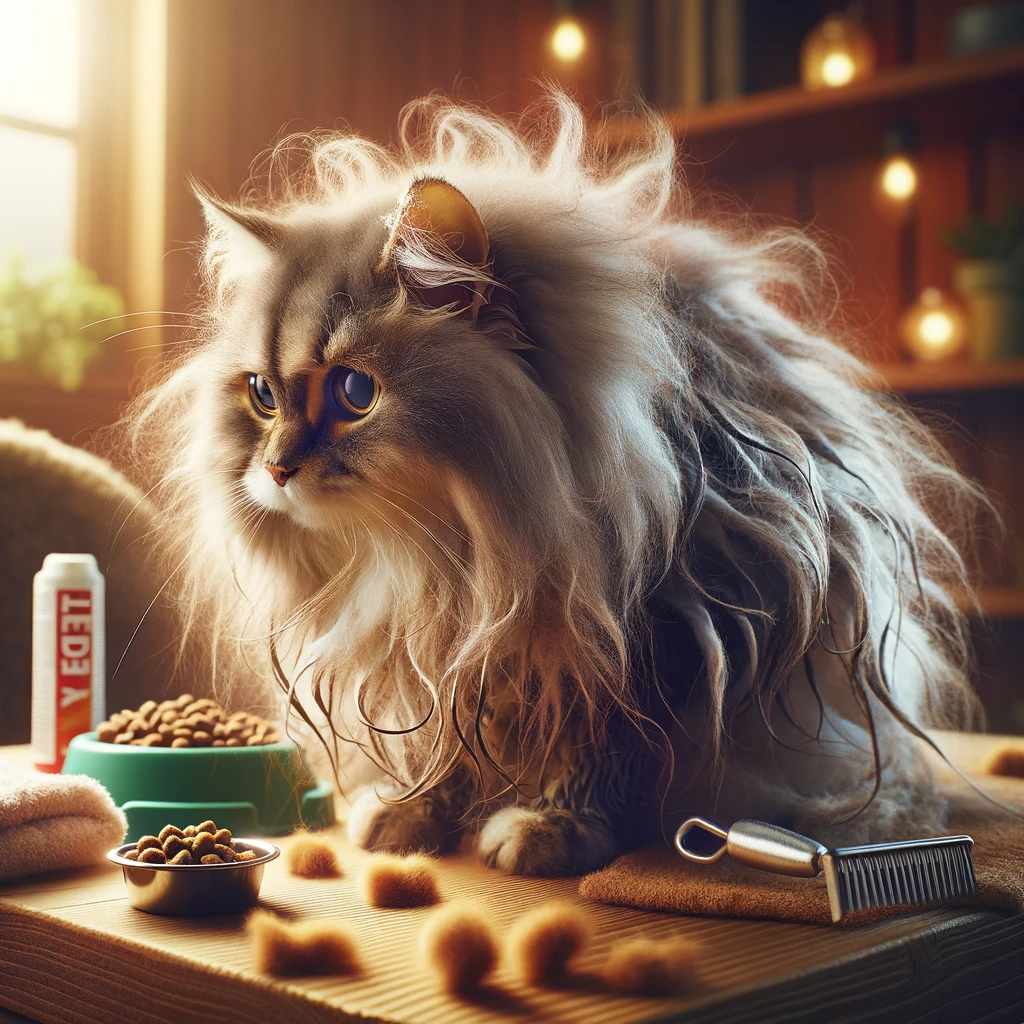
Health-Related Issues
Got a chubby kitty? Obesity can be a sneaky culprit. It makes grooming a tough task for your furry friend. Add arthritis to the mix, and you’ve got a double whammy affecting those hard-to-reach spots. (1)
Skin infections—not a pretty subject, but super important. These can lead to discomfort and changes in your cat’s coat appearance, leaving it looking divided rather than unified. (2)
And hormonal imbalances? Let’s just say they can wreak havoc with more than your cat’s mood, impacting their fur’s health and appearance.
Environmental and Behavioral Factors
What about stress? Yep, just like us, cats can wear their worries in their whiskers—or rather, in their coat. Emotional stress can lead to over-grooming or neglect, both of which can give their fur that separated look.
Nutritional Influences on Fur Health
You are what you eat—and so is your cat’s coat! A lack of essential nutrients can leave your cat’s fur looking less like silk and more like old string. Here’s a quick bite of info:
- Omega fatty acids: The secret sauce for a shiny coat. (3)
- Vitamins and minerals: Like A, B, E, and zinc are coat conditioners from the inside out. (4)
Pssst, a good balance of proteins and fats in their diet can turn a lackluster coat into a glossy mane—just like magic!
So remember, keeping your cat’s fur fabulous is all about understanding these causes and getting ahead of them.
Preventative Strategies for Maintaining Healthy Fur
Routine Care and Grooming Techniques
You should brush your cat’s fur daily, especially if it’s a long-haired breed.
However, even cats with short hair can benefit from regular grooming to prevent matting and distribute natural oils and loose hair throughout their coat.
Additionally, frequent bathing should be avoided as it can strip away the natural oils from your cat’s fur and cause skin irritation, especially if your cat has underlying health problems.
Think of it as a mini spa day for your kitty!
Choosing the Right Grooming Tools
Got a cabinet full of grooming tools? If not, it’s time to stock up! A quality bristle brush should be your go-to tool for smooth coats. For thicker fur, a slicker brush will do just the trick.
And let’s not forget a metal comb for those pesky tangles.
| Fur Type | Recommended Tool |
| Short & Smooth | Bristle brush |
| Thick & Long | Slicker brush, Metal comb |
Don’t forget to introduce your cat to baths with a gentle, cat-friendly shampoo. This helps in keeping their coat in tip-top condition.
Environmental Adjustments for Optimal Health
Creating a calming environment is like giving your cat a mental comb-through. Have you tried setting up a quiet retreat for your feline? A cozy spot with their favorite blanket can work wonders for their wellbeing. (5)
Less stress equals a more glorious coat!
Lastly, playing with your cat isn’t just fun – it’s actually a fluffy fur secret! Engaging in play helps reduce anxiety and maintains a healthy coat.
Who knew that the toss of a ball could double as a fur treatment? Remember, a happy cat is a healthy cat, and a healthy cat has fabulous fur!
When to Seek Professional Help
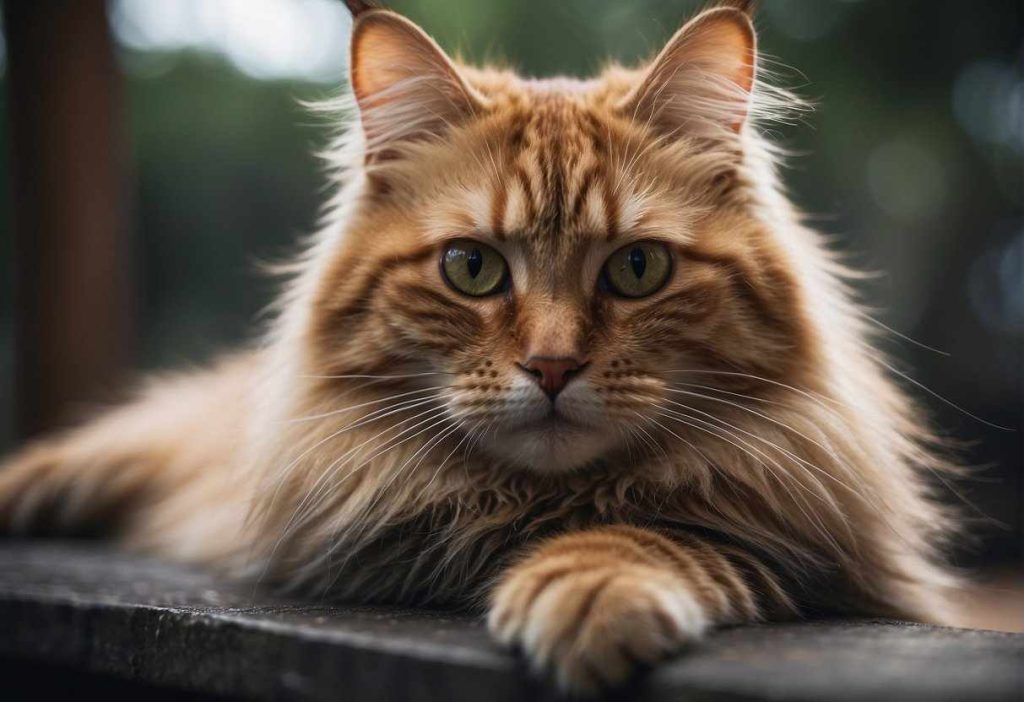
When exactly should you book that vet appointment?
- Persistent Separation: If you’ve tried regular grooming and there’s no improvement, it’s time to get a professional’s opinion.
- Underlying Conditions: Hair separation can be symptomatic of allergies, parasites, or skin infections. A vet can get to the root of the problem. (6)
- Behavioral Changes: Is your cat grooming less or showing signs of discomfort? Stress, pain, and illness may be the cause.
Here’s a quick checklist to assess if your cat might need a vet visit:
- Changes in grooming habits
- Excessive scratching or skin irritation (7)
- Overweight or unable to groom properly
- Loss of appetite or other behavioral shifts
Diagnostic tests your vet might recommend include blood work, a skin scrape, or allergy tests. These can help pinpoint issues from nutritional deficiencies to more complex conditions like hyperthyroidism.
Remember, a trip to the vet is not just about solving the mystery of the scruffy coat. It’s about ensuring your purr pal’s overall health is top-notch.
So, listen to your cat’s instincts – if something feels off, a veterinarian is your best ally in keeping your cat happy and healthy. A sleek coat is just the cherry on top!
However, if the underlying problem is more complex and requires specialized care, such as a change in your cat’s diet, your veterinarian may refer you to a dermatologist for appropriate treatment.
Nutritional Plans for Fur Vitality

Building a Nutrient-Rich Diet
Lean meats like chicken or turkey, rich in protein, should be the cornerstone of your furry friend’s meals—after all, cats are carnivores at heart.
Not forgetting the omega-3 fatty acids, found in fish such as salmon, can give a boost to skin and fur health.
Vitamins and minerals are your cat’s coat’s best pals. A balanced intake of vitamin A and zinc can promote fur growth and repair skin tissue.
But remember, too much of a good thing can be trouble, so moderation is key!
Homemade Diets and Commercial Food Selection
Confused between whipping up a storm in your kitchen or picking the right commercial cat food? Here’s a purr-worthy checklist:
- High-quality protein: at the top of the ingredients list.
- Low or moderate fat: just enough for energy and coat shine.
- Vitamins E and B: for that extra fur glow.
- A complete & balanced stamp: It’s your quality assurance!
Evaluating Food Options for Coat Health
When browsing, keep an eye out for the AAFCO (Association of American Feed Control Officials) statement, ensuring the food meets the nutritional standards.
Remember, while a fancy feast can seem enticing, your furball’s perfect diet is the one that keeps its coat as magnificent as it feels on the inside.
Have a chat with your vet about the best nutritional plan for your specific kitty superstar!
Creating a healthy, nutrient-packed eating schedule might just bring the bounce and shine back into every strand of your cat’s fur. Now that’s what I call a fur-nomenal transformation!
Breed-Specific Advice and Personalized Care

Maine Coon or Persian? Your gorgeous long-haired breeds like Maine Coons or Persians are famed for their luxurious coats. However, their thick fur can also mean more opportunities for separation.
These breeds often require daily brushing to prevent matting and keep oils evenly distributed.
- Regular grooming is key:
- Use a wide-toothed comb for detangling.
- Gently brush to distribute natural oils.
Sphynx or Cornish Rex? Who would’ve thought that even the breeds with less fur need careful attention? Oil buildup can cause fur separation even in these cats, although they often have less fur to contend with.
- Bathing tips for short-haired breeds:
- Bathe sparingly, as over-bathing can strip oils and cause skin irritation.
- Always use a cat-specific shampoo.
Caring for Your Specific Cat Every cat is unique, so what works for one may not work for another. Your cat’s health, lifestyle, and even diet can influence their coat’s condition.
- Dietary considerations: Ensure your cat’s diet is rich in Omega-3 fatty acids.
- Stay hydrated! A water fountain can encourage drinking.
Remember, if you’re ever in doubt about your cat’s coat condition, reach out to your vet. They can offer personalized advice that takes into account your furry friend’s breed, lifestyle, and any particular quirks.
Keep up the good work, and your cat will be flaunting a healthy, shiny coat in no time!
Emotional and Behavioral Considerations
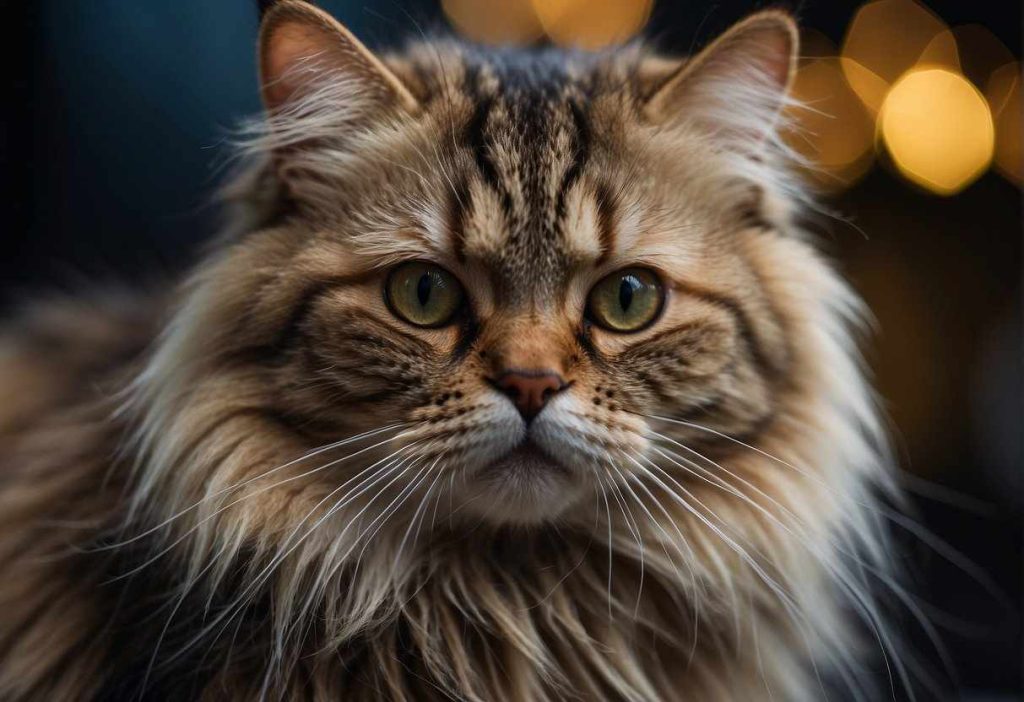
It could tell how your furry friend is feeling on the inside, particularly when it comes to their cat’s ability to groom themselves. Cats are clever little creatures, aren’t they?
If you’ve spotted signs of separated fur, it’s like a secret message, letting you know they might be experiencing emotional and behavioral issues, which can also affect their cat’s ability to groom and overall health, such as stress or illness.
Now, what’s stirring up the pot? It could be several things. Maybe the hustle and bustle of the house, a new pet pal, or changes to their cozy routine.
Cats, much like us, appreciate a calm and predictable environment. So it’s essential to tackle these stressors head-on to improve their emotional well-being.
Let’s talk about setting up shop for success:
- Create a Safe Zone: Give your cat a personal retreat, a space with their favorite knick-knacks where they can unwind.
- Playing is Preemo: Regular playtime is top-notch for reducing anxiety and building confidence.
- Furry Friends: A buddy can go a long way. If your cat’s a social butterfly, consider a companion.
Could the issue be a bit deeper, though? Perhaps it’s not just environmental factors but also something brewing inside that’s throwing them off balance.
Emotional and physical health are buddies who like to stick together. Ensuring regular visits to the vet and staying on top of health checks will help catch anything amiss and keep your cat’s happiness meter up.
Just imagine that silky, flawless fur once you’ve tackled the emotional tangles!
Understanding your cat’s emotional needs is a fantastic way to enrich the bond you share. Be observant, be proactive, and with a sprinkle of patience, you’ll be on the path to solving the mystery of the separated fur.
Isn’t it wonderful to know you’ve got the power to make a world of difference in your cat’s life? Now, let’s turn those separated strands into the ultimate fluff of happiness!
Success Stories and Real-Life Examples

Lucy’s Lovely Locks
Ever wondered if those before-and-after photos are just a fluke? Well, Lucy’s story will have you thinking twice! After months of battling with separated fur, Lucy’s owner decided to take action.
With regular brushing and a switch to a more balanced diet, Lucy’s coat transformed from clumpy to sleek. A bi-weekly brush routine and some omega-3 supplements did the trick!
Table 1: Lucy’s Fur Routine
| Action | Frequency | Result |
| Brushing | Bi-weekly | Smoother Fur |
| Omega-3 | Daily | Healthier Skin & Coat |
Tom’s Tangle-Free Triumph
Tom the tabby had a real issue with greasy build-up in his fur. His owner started a daily grooming session and introduced a gentle, cat-friendly shampoo into the mix.
Guess what? Within a month, Tom was flaunting a soft, separated-free coat!
But the real gem? They reduced the baths and focused more on dry grooming, using a therapeutic shampoo prescribed by their veterinarian as part of Tom’s treatment regime.
This helped to alleviate his skin allergies and keep his fur healthy and separated-free.
- Before: Clumpy and dull
- After: Smooth and shiny
Max’s Matte Madness
And what about Max? A long-haired beauty stuck in a matted mess. His owner picked up a detangling comb and sought advice from a vet. Max needed some extra attention due to his length.
With patience and regular care, Max went from matted to magnificent. The secret? Comb the fur in sections to tackle knots before they get out of hand.
- Start with a wide-toothed comb
- Move to a finer-toothed tool
- Compliment with regular vet check-ups
Isn’t it encouraging to see such changes? If you’re facing a similar furry conundrum, why not try these tips? Your kitty’s coat could go from matted to majestic, too!
Remember, every cat is unique, so finding the right routine might be a bit of trial and error. But when you see that shine in their fur, you’ll know it’s all worth it!
Reassurance and Support for Cat Owners
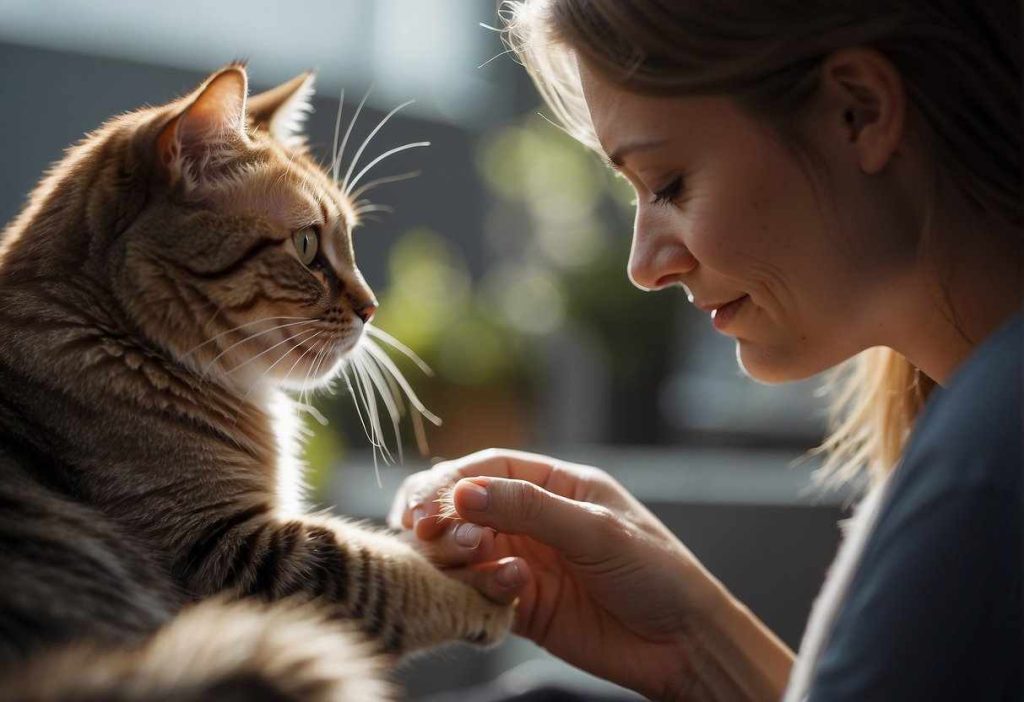
Let’s tackle this together and get that coat back to purr-fection!
First steps first:
- Light Inspection: Take a closer look at your cat’s coat. Are there any signs of dirt, fleas, or ticks? Any weird smells?
- Regular Grooming: Brushing can often resolve minor separations. Plus, it’s a great way to bond with your kitty!
Friendly Advice:
- Not a Vet? That’s okay! If grooming doesn’t do the trick, it’s time for a professional opinion. Vets see this sort of thing all the time and can offer valuable insights and solutions.
- Diet Check: Is your cat eating a balanced diet? Sometimes what they eat (or don’t) can affect their fur’s health.
Stay Positive: Most fur issues aren’t a cat-astrophe. A quick vet check can ease your mind.
Remember, you’re doing a great job! Spotting a change in your cat’s coat and acting on it is the mark of a purr-fectly wonderful cat owner. Keep up the proactive care; your furry friend is lucky to have you!
Quick Recap

Here’s a rundown of what might be happening with your kitty’s coat:
- Grooming Habits: When cats stop grooming, natural oils can accumulate, leading to separated fur. It’s kind of like if you skipped a few showers; things start to look a bit messy.
- Bathing Frequency: If you’re a little too enthusiastic with baths, you might be contributing to the problem. Cats usually don’t need frequent baths, and too much washing could strip their fur of natural oils, leaving it separated and dull.
- Health Concerns: Sometimes, separated fur can point to an underlying health issue, such as poor nutrition or illness.
What should you look out for to keep your feline friend’s coat in tip-top shape?
- Regular Checkups: Stay on track with vet visits. Vets are your go-to for unraveling the mysteries behind your cat’s fur situation.
- Balanced Diet: Ensure your cat’s diet is nutritionally complete. The right nutrients can transform a dull coat into a shiny cloak of fur your cat can proudly parade.
- At-Home Care: Brushing your cat’s fur can prevent matting and remove excess oils and dirt.
Remember, your cat’s comfort and health go paw-in-hand. Keeping an eye on their coat could give you clues about their overall well-being, so it’s important to pay close attention.
When in doubt, have a chat with your vet — they’re the ultimate guide in the quest for your cat’s well-being.
Frequently Asked Questions
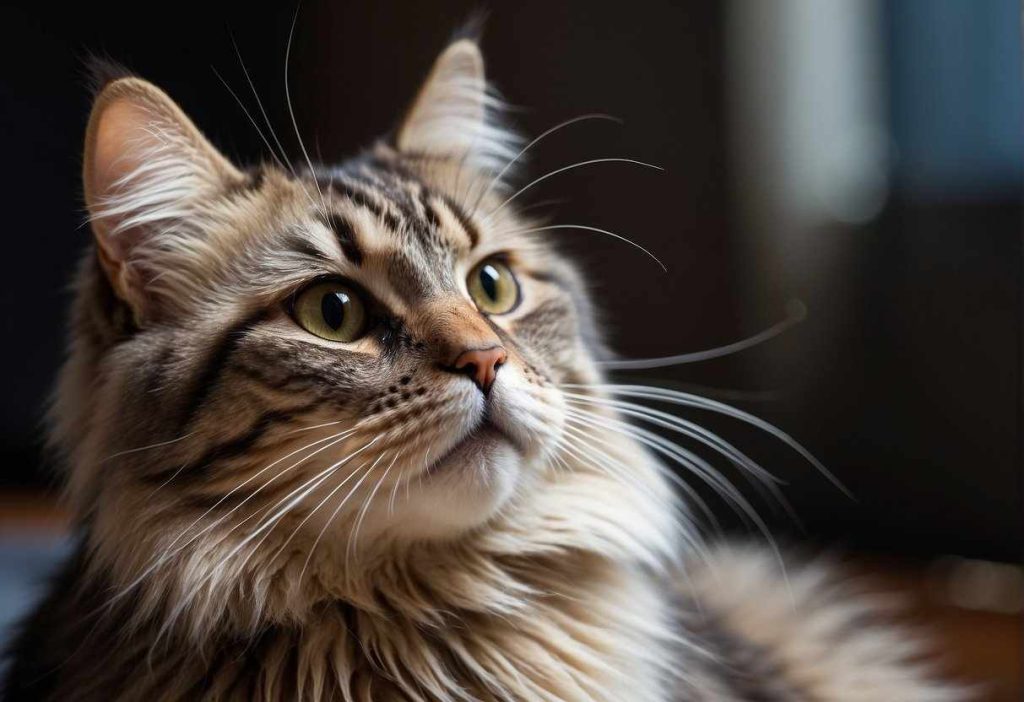
When your feline friend starts sporting fluff that seems to part like the Red Sea, you may be wondering why their once sleek coat is now a parted panorama.
Let’s answer those burning questions and ensure your kitty stays as majestic as they ought to be.
What are the first signs of fur separation in cats?
The early signs include clumps or strands of fur that stick together, making the coat look uneven.
You might also notice your cat grooming less than usual or patches of fur that seem especially greasy or matted.
Can diet really affect my cat’s fur health?
Absolutely! A diet deficient in essential nutrients can lead to a lackluster coat.
On the flip side, a balanced, nutrient-rich diet can promote a glossy, healthy fur that doesn’t separate easily.
How often should I groom my cat to prevent fur separation?
Regular grooming, depending on your cat’s breed and fur length, can help prevent separation.
Short-haired cats may only need brushing once a week, while long-haired breeds might require daily attention.
When is it time to see a vet about my cat’s fur separation?
If you’ve tried improving grooming and diet without success or notice skin irritation, excessive itching, or balding, it’s vet time.
Underlying health issues might be playing a role.
What are some effective stress-reduction techniques for cats?
A serene environment can work wonders. Engage with your cat through regular play, and provide hideaways and perches.
Consistent routine and cuddle time can also help in managing your cat’s stress levels.
Are there any breed-specific issues with cat fur that I should be aware of?
Yes, certain breeds are prone to fur issues.
For example, Persians and other long-haired breeds may require more frequent grooming to prevent fur separation due to their dense coats.
Can environmental factors lead to fur separation, and how can I mitigate them?
Environmental factors like humidity, indoor heating, and allergens can affect your cat’s fur.
To mitigate these, maintain a stable indoor environment and consider using an air purifier to reduce airborne irritants.
- The Ultimate Overview to Actual Cash Gambling Establishments - July 1, 2025

